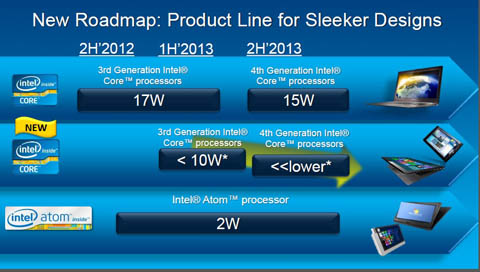If you want to build or buy an ultrathin laptop with Intel inside, you've got a difficult choice. Right now, you can pick between a powerful Core i3, i5 or i7 processor which might not make it through your average workday, or a comparatively weak Atom chip with an estimated 10 hours of battery life. If you're willing to wait until the middle of next year, though, there might be a third option. Intel's planning to drastically reduce the power consumption of its existing Ivy Bridge silicon architecture to a TDP (thermal profile) of just 10 watts.
Currently, the ultra-low voltage Ivy Bridge processors you'll find in thin laptops like Apple's MacBook Air have a 17-watt TDP, and though Intel already provides software that can tune them down to 13 watts as well, we'd thought that we'd have to wait for Intel's next-gen Haswell design to see a 10-watt design. Not so: at the Intel Developer Forum in September, the company announced that it will be able to bring Ivy Bridge down to ultrabooks with sub-10-watt parts.

We double-checked with Intel today, and the idea is still on track: "We’ll be introducing a new line of low power chips targeted to operate at about 10 watts initially. Thanks to the benefits of Intel’s leading 22nm process technology, Intel is planning to offer very limited quantities of the new low-power processor line with the 3rd Gen Intel Core processor family in 1H’13," wrote a spokesman.
"But it won’t be introduced significantly in volume until the 4th-gen Core processor family later in 2013," cautioned the Intel representative. Intel's positioning the chips as a stopgap until Haswell arrives.
As always, it's hard to say how the actual designs of laptops and tablets might change to match the lower-power chips. Since TDP refers to the amount of heat that needs to be cooled from a piece of chip, rather than its actual power consumption, it doesn't necessarily correspond to an increase in battery life. If a chip needs less cooling, that cooling requires less space, which allows a manufacturer to put in a larger battery instead... or shrink the entire dimensions of the laptop or tablet to appear thinner and more attractive, an increasingly popular alternative.
Microsoft's upcoming Surface Pro tablet, for instance, is a full 4mm thicker and half a pound heavier than the Surface RT, probably due to its larger battery and cooling for its more powerful Core i5 chip. Despite the larger battery, though, Microsoft anticipates it will only get half the battery life of the Tegra 3 alternative. If Microsoft had the 10-watt parts, it could theoretically make the Surface Pro thinner, or last longer, or a bit of both.
It's also unclear whether Intel has managed to maintain the same performance at the lower TDP. It's possible the new chips bring down performance as well.
:format(webp)/cdn.vox-cdn.com/uploads/chorus_asset/file/14158633/intel-ivy-bridge-crate-stock-1024.1419979049.jpg)